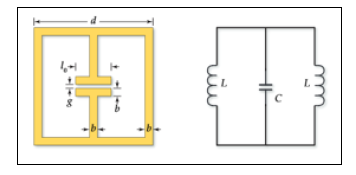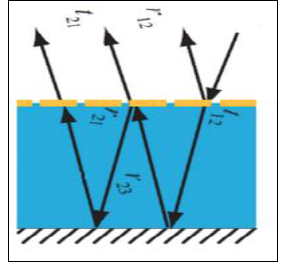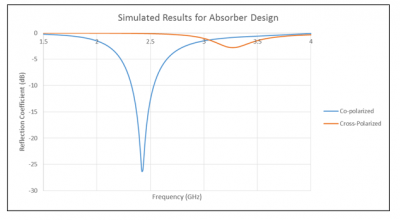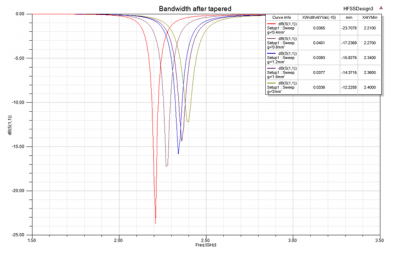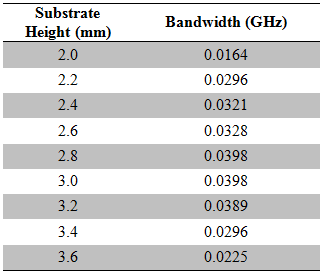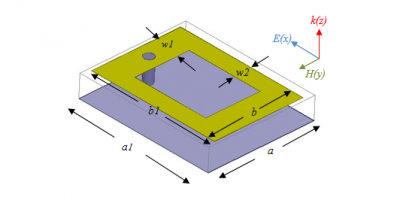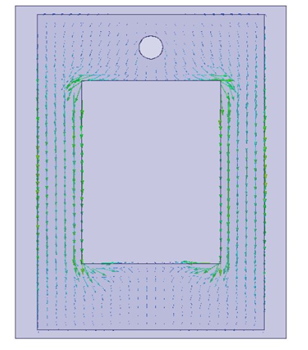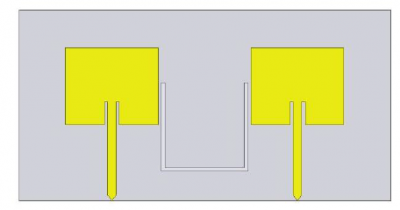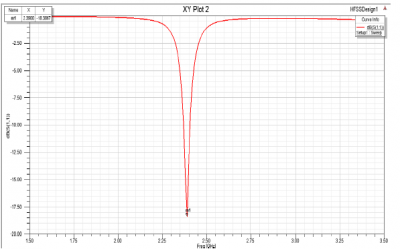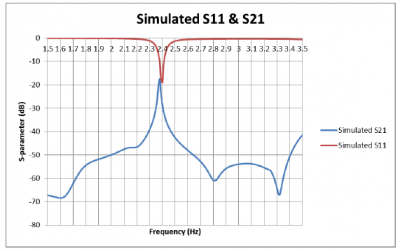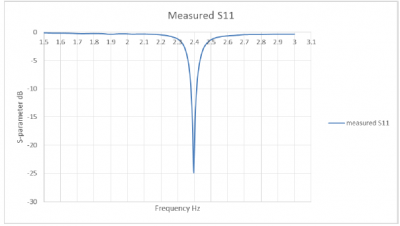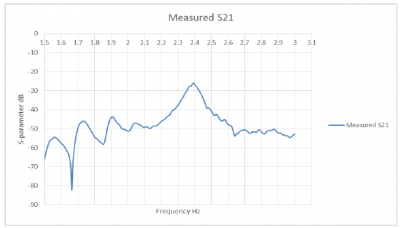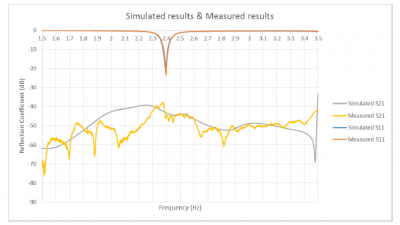Difference between revisions of "Projects:2015s1-28 Wireless Rotation Detector"
(→Metamaterial Absorber Design) |
(→Antenna Design) |
||
| Line 208: | Line 208: | ||
== Antenna Design == | == Antenna Design == | ||
| − | |||
| − | |||
| − | |||
| − | |||
| − | + | [[File:Dumb bell like structure.PNG|400px|thumb|center|alt text]] | |
| − | + | ||
| + | 1. Method | ||
| + | |||
| + | This section is related to antenna design method and will introduce two failed methods and a successful method that is able to reduce the coupling between two antennas less than -40dB. The absorber design method and software algorithm will be introduced in latter section. | ||
| + | 1.1 Antenna structure design method | ||
| − | [[File: | + | According to the project requirement, transmission and receiving antennas should be on same side. So the dual patch antennas are decided for this project. The dual patch antennas should be built on same substrate and one is used to receiving and another one is used to transmission. So the antennas structure should be designed at first. The dimensions of the microstrip path antenna are determined by following parameters: |
| + | |||
| + | * Dielectric constant of substrate (εr) | ||
| + | * Thickness of substrate (h) | ||
| + | * Resonance frequency of antenna (f) | ||
| + | |||
| + | Based on the three parameters above, the dimension of microstrip patch antenna can be determined. So there are four key parameters are calculated and used for simulation in HFSS. | ||
| + | |||
| + | * The length (L) of the patch | ||
| + | * The width (W) of the patch | ||
| + | * The width (W0) of the feed line | ||
| + | * The length of rectangle (y0) which should be substrate on patch | ||
| + | |||
| + | 1.2 Reducing coupling method | ||
| + | |||
| + | Using the ‘U’ shape structure between two patch antennas. | ||
| + | From figure 6, this method is also cutting slots on ground plane between two same directional patch antennas and the ‘U’ shape is composed of three slots. The principle of the ‘U’ shape structure is based on an isolation of reverse phase coupling for reducing coupling. | ||
| + | |||
| + | [[File:Dual patch antennas with 'U' structure.PNG|400px|thumb|center|alt text]] | ||
| + | |||
| + | 2. Antenna results | ||
| + | |||
| + | 2.1 Design calculation result: | ||
| + | |||
| + | As referred above, in order to increase the bandwidth of antenna, the RT/duroid 5880 has been chosen as substrate. The substrate parameters and the desired resonance frequency of the antenna are as follow: | ||
| + | |||
| + | * Dielectric constant of substrate εr is 2.2 | ||
| + | * Thickness of substrate h is 1.6mm | ||
| + | * Resonance frequency f is 2.4GHz | ||
| + | |||
| + | According to the calculation methods from the Balanis, the dimension of microstrip line patch antenna can be determined based on above the parameters. | ||
| + | |||
| + | * The length (L) of the patch | ||
| + | * The width (W) of the patch | ||
| + | * The width (W0) of the feed line | ||
| + | * The length of rectangle (y0) which should be substrate on patch | ||
| + | |||
| + | [[File:Calculated parameters of patch antenna.PNG|400px|thumb|center|alt text]] | ||
| − | + | [[File:Optimal result for parameters.PNG|400px|thumb|center|alt text]] | |
| − | |||
| − | |||
| − | |||
| − | |||
| − | |||
| − | 2. | + | 2.2 Simulated and measured result |
| − | |||
| − | |||
| − | |||
| − | |||
| − | |||
| − | |||
| − | |||
| − | |||
| − | |||
| − | + | This section includes single antenna, dual patch antennas without ‘U’ structure, and dual patch antennas with ‘U’ structure. Each situation contains simulated result, measured result and comparison as well as relevant discussion. | |
| − | |||
* Single patch antenna: | * Single patch antenna: | ||
| − | |||
| − | |||
| − | + | The Figure bellow illustrates the reflection coefficient at resonate frequency 2.4GHz. The S11 is around -23.78dB at resonance frequency 2.4GHz, which means nearly 99.3% energy has been transmitted through the patch antenna. The reflection coefficient is lower and the input impedance match the transmission line. So the input impedance is close to 50 ohms. | |
| − | The | + | |
| − | [[File: | + | [[File:Reflection coefficient for single patch antenna.PNG|400px|thumb|center|alt text]] |
| + | |||
| + | * Dual patch antennas (Without ‘U’ structure): | ||
| − | + | Due to large power drop by using single antenna receiving and transmission, the dual patch antenna is introduced. In the dual patch antennas system, one antenna is used to receiving and another one is used to transmission simultaneously. | |
| − | + | The following figures illustrate simulated results of reflection coefficient S11 and coupling effect S21 of dual patch antenna without ‘U’ structure. | |
| − | |||
| − | + | Simulated result: | |
| − | |||
| − | [[File: | + | [[File:Reflection coefficient & coupling effect for dual patch antennas.PNG|400px|thumb|center|alt text]] |
| − | + | Measured results: | |
| + | The following figures illustrate measured results of reflection coefficient S11 and coupling effect S21 for dual patch antennas. | ||
| − | |||
| − | + | [[File:Measured reflection coefficient for dual patch antennas.PNG|400px|thumb|center|alt text]] | |
| + | [[File:Measured coupling effect for dual patch antennas.PNG|400px|thumb|center|alt text]] | ||
| − | + | Comparison: | |
| − | |||
| − | |||
| − | |||
| − | |||
| − | |||
| − | |||
| − | |||
| − | |||
| + | From figures above, comparing simulated result of reflection coefficient S11 that is around -19dB at resonance frequency 2.4GHz with measured result of reflection coefficient S11 that is -18dB at 2.4GHz, it is obviously that the simulated result is very close to measure results and the resonate frequency is in ISM frequency bandwidth. The S11 result is acceptable. | ||
| + | The most important characteristic for the project which should be improved is crosstalk. From figures above, comparing the simulated result of crosstalk coefficient S21 that is around -19dB at resonate frequency 2.4GHZ with measured one which is around -23dB at resonate frequency. The coupling between two patch antennas is too large for the project to accept since it will have large effect on receiving. | ||
| − | |||
| + | * Dual patch antennas with ‘U’ structure: | ||
| + | Using ‘U’ structure between two antennas, the following figures illustrate simulated result of reflection coefficient and coupling effect as well as measured. | ||
| + | The figure 16 and figure 17 illustrate prototype of dual patch antennas with ‘U’ structure | ||
| − | + | [[File:Simulated results with measured results.PNG|400px|thumb|center|alt text]] | |
| − | |||
| − | |||
== Reference == | == Reference == | ||
Revision as of 15:29, 22 October 2015
Contents
Supervisors
Honours students
- 2015: Guowei Deng and Shuopeng Wang
Project objects
Scope
- Design and construct a portable wireless device which can accurately measure the speed of rotating object.
Specific Aims
The aim of the project is to design and construct a portable wireless device which can be used for rotation speed measurement. The device is supposed to consist of antennas, absorbers, Arduino UNO Board with software, etc. The outcomes of the project will be as follows:
- A metamaterial absorber with resonant frequency of 2.4GHz
- A planar dual-antennas with capability of transmitting and receiving signals
- A software system for rotation speed calculation
The device should be able to measure the rotational speed of various objects such as sport equipment, car tyres, turbines, fans, etc. The system shall be operational under a set of circumstances and able to achieve reliable results.
Background & Significance
- Motivation
The rotation speed measurement devices have already ubiquitously used in industries. They are embedded on turbines, wheels or fans to extract the rotation speed of objects. However, most of commonly used angular speed measurement devices, such as laser tachometer, use visible light. One of the constraints in such devices is that the line of sight cannot be impaired [1]. Hence, the optical devices cannot be used if there is an obstacle between rotating objects and the test devices or under sophisticated circumstances such as fog or smoke.
In order to improve the performance of the measurement device, the 2.4GHz electromagnetic waves will be used instead of visible light due to its good ability of propagation. Accordingly, the devices can be used under more complicated situations, even if the line of sight has been impaired, once delivered.
- Technical Background
1. Polarization of Antennas
The polarization of antenna is defined as “the polarization of the wave transmitted (radiated) by the antenna” [2]. There are 3 different types of polarization including linear polarization, circular polarization and elliptical polarization [2]. All of them are defined as “time-varying direction and magnitude of the electric field vector” [2].
2. Polarization Loss Factor
Polarization loss is defined as the power loss due to polarization mismatch. For example, if a horizontally polarized antenna communicates with a vertically polarized antenna, the vertically polarized antenna will transmit vertically polarized waves, while the horizontally polarized antenna can only receive horizontally polarized wave. Thus, there is no power transfer between a horizontally polarized antenna and vertically antenna according to the reciprocity principle. In contrast, if 2 vertically polarized antennas communicate with each other, the power transfer will be maximum. Hence, if two linearly polarized antennas are rotated from each other by an angle θ, the polarization loss factor base on power loss for polarization mismatch is defined as
𝑃𝐿𝐹 = 𝑐𝑜𝑠2θ
3. Metamaterial Absorber
Metamaterials are man-made materials with the unique characteristics, such as negative permittivity and permeability, which cannot be found in natural materials [3]. The metamaterial absorber has been one of the most important applications due to its astonishing properties [4]. A single metallic metamaterial absorber typically consists of a LC resonant circuit and a ground plane, separated by a substrate in between [5]. For example, as shown in Figure 1, the capacitor-like structure can provide capacitance and is connected with two loops in parallel, which can be considered as two inductors in the resonant circuit [6]. The resonator can strongly respond to a properly oriented electric field due to the capacitor-like structure when the circuit is driven by EM field at resonant frequency.
The metamaterial absorber is expected to have the ability of dissipating the incident waves inside of the structure with limited energy reflected back from it [8]. As shown in Figure 2, the incident wave is transmitted into the substrate at working frequency. The surface current will be created along the ground plane when the wave reached the bottom layer. Similarly, remaining energy will be reflected back to the resonators which will also generate another surface current on the top layer. These two currents have same magnitude with opposite directions, resulting in a destructive interference [8]. Hence, the thickness of the substrate should be carefully chosen for the effective destructive interference.
Key Requirements
From the introduction of background and related work, several key requirements have been defined as following:
- Metamaterial absorber shall absorb at least 90% (-10db) power at 2.4GHz when it has
same polarization as the transmitting antenna.
- Dual antennas shall work at 2.4GHz and crosstalk between 2 antennas shall be less
than -40dB.
- Portable system shall be operational up to 50cm from the rotating object.
- Portable system shall accurately measure the angular speed of the rotating object in
both low and high speed.
- While the mutual coupling in dual antennas is reduced, the dimensions of dual antenna
should remain small, and specifically the antenna system should be planar.
- The bandwidth for the isolation should be able to cover the bandwidth of the antenna.
Technical Challenge
- Antenna Design
The technical challenge for antenna design is to figure out an appropriate method to reduce crosstalk between dual antennas with the frequency and substrate thickness specified. Some possible methods have already been mentioned in Section 3.2.2. However, all the methods will have side effects on the performance of the antenna including input impedance matching, efficiency, resonant frequency, etc. Hence, the method should be operational for coupling reduction with all side effects minimized. Furthermore, the method should not dramatically change the overall dimensions of the antenna, and specifically the antenna system is expected to be planar.
- Metamaterial Absorber
Resonant frequency and absorption ability are two key characteristics of the metamaterial absorber, which are influenced by the metallic structure and thickness of substrate. Hence, 2 variables need to be considered in absorber design in order to achieve the requirements. Moreover, the material of substrate is supposed to be FR4, a low-cost material with permittivity varying from 4.2 to 4.8. The variation of the permittivity has impact on the resonant frequency, which may lead to failure in absorber design. Hence, a relatively wide bandwidth has to be achieved in order to overcome the uncertainty.
Proposed Approaches
- Method exploited - ‘Divide-And-Conquer’.
- The entire project can be decomposed into several aspects.
- Hardware (design required)
- Metamaterial Absorber
- Dual-Antennas
- Software
- Calculation Algorithm for rotating speed
- GUI
- Other Components (from market or school)
- VCO
- Arduino UNO Board
- Power Detector
Hardware Design
Hardware design will begin with understanding the key requirements and specifications of the hardware. Most of the hardware design will be implemented in the commercial software package HFSS which is a professional software for simulating 3D full wave electromagnetic fields. The group member will fabricate the designed hardware after hardware has been designed in HFSS. The next task for hardware is to measure the prototype and compare the practical result with simulation results. If the prototype fails to meet the requirements, the group will refer back to design stage to redesign prototype until it meets requirements
Software Design
The software design will start after antenna and absorber design have been finished. The software design will be in C language based on the Fourier Transform. To test the validity of the software, the group members will combine software, hardware and other components together. If the software cannot accurately measure rotating speed of objects which is driven by a motor, the project group will return to previous stage to redesign the software.
Schedule and Milestone
- Milestone in Semester 1
- Milestone in Semester 2
Metamaterial Absorber Design
1. Method
1.1 Metamaterial Absorber Design
According to the introduction given in the Section 1.3, the existing absorber can only absorb 36% of incident power at 2.4 GHz when it has the same polarization with the antenna. The main cause for this is that the bandwidth of the existing metamaterial absorber is only 0.03 GHz, which is too narrow. As a consequence, the performance of the absorber will significantly drop if the resonant frequency slightly shifts. Accordingly, the main purpose for the new absorber design is to achieve distinct absorption performance and relatively wide bandwidth. This section will demonstrate some different methods which have been tried to increase the bandwidth of the absorber.
1.1.1 Structure Tapering
In section 3.13, we presented the characteristics of ELC resonator and its equivalent circuit. The ELC resonator can be modelled as a parallel LC resonator and the resonant frequency can be adjusted by changing resonator’s dimensions. In order to enhance the bandwidth, we need to consider the impact of the Q factor. For a parallel RLC circuit, the Q-factor is defined as
Q=R√(C/L)
And the bandwidth can be expressed as
BW=f_r/Q
In order to reduce the Q factor and remain the same resonant frequency, we tapered the loop width to increase the inductance and increased the gap to decrease the capacitance of the ELC resonator. Figure 4 compares the original ELC resonator and the tapered one. The original structure we proposed has an ELC resonator and a ground plane, separated by the FR4 substrate with height of 3.2mm. The ELC resonator has the dimensions of a=15mm, g=0.4mm, d=12.6mm, b=0.8mm, l=3.6mm and copper thickness of t=0.035mm. The tapered resonator has the gap size varied from 0.4mm to 2.0mm and loop width decreased from 0.8mm to 0.1mm.
From Figure 5 illustrates the reflection coefficient S11 for the metamaterial absorber. The transmission coefficient is 0 because of the metal ground plane. It is interesting to note that the metamaterial absorber resonates at frequency of 2.4GHz with minimum reflection coefficient -18.75dB with the bandwidth is 0.0389GHz.
Figure 6 shows the changes in the bandwidth as the gap size increases from 0.4 to 2mm. We can conclude that the bandwidth increases as gap size g increases until 0.8mm, then the bandwidth keeps decreasing as gap size increases, which is completely different from the analysis about Q factor before. In addition, we can observe that the return loss at resonance also increases as the gap size increases.
The reason for the results mentioned above can be explained by using interference theory, which leads to the multiple reflection and transmission inside of the absorber structure. Figure 3 shows that the metamaterial absorber has 2 layers: resonator and ground plane. The overall reflection is the superposition of the multiple transmissions and reflections [12], which is defined as:
where φ1=∅12+∅21+∅23+2β, φ2=∅12+∅23+∅21+2β, β=-√(ε_FR4 ) k_0 d/cos(α_s), k0 is the free space wave number.
The formula demonstrates that the overall reflection is associated with the reflection and transmission coefficient of ELC resonator, the reflection coefficient of ground plane, the height of the substrate and the angle of incidence. Hence, the overall bandwidth of the reflection coefficient may be too small if we substitute all relevant values into the formula. Also, due to the complexity of the overall reflection, the bandwidth enhancement by structure tapering may not work for the metamaterial absorber since we only increased the bandwidth of the ELC resonator.
1.1.2 Substrate Height
We then investigated the impacts of the substrate height on the absorptivity and bandwidth. Based on the structure proposed in Section 4.1.1, we varied the substrate height from 2mm to 3.6mm.
Table 1 shows the bandwidth as the substrate height changes. It is interesting to note that the bandwidth starts with 0.0164 at 2.4GHz and increases until height increases to 2.8mm. Then the bandwidth start to decrease as the substrate height keeps increases. The optimized result we can obtain was 0.0398GHz, which is still relatively narrow. The reason for this can still be explained by the formula in section 4.11. Due to the complexity of the overall reflection, the bandwidth cannot be significantly improved by only changing the substitute height. In conclusion, the bandwidth still does not meet the specification although it can be slightly increased by varying the substrate height.
1.1.3 Via
After some unsuccessful trials, we finally presented the design of the metamaterial absorber operating at 2.4 GHz by using a via. A unit cell of proposed absorber is shown in Figure 7. It is a 3 layer structure which has a metallic loop at the top, a ground plane and a substrate in between. A 150Ω resistive load is used as a via to connect the top and bottom layer. The absorber is designed to operate at 2.4 GHz with the optimized dimensions given by a1=20mm, a=16mm, b1=19mm, b=13.4mm, w1=4, w2=2.6mm.
The unit cell was hosted on the top of a 3.2mm thick FR-4 dielectric substrate with a loss tangent of 0.025 and a dielectric constant of εr=4.4. The simulation for ELC resonator was performed with a full-wave electromagnetic simulator, Ansoft HFSS. The unit cell was placed in a waveguide with Master and Slave boundary condition. The boundary condition was selected for the unit cell in order to realize TEM mode excitation with polarization shown in Figure 7.
Figure 8 illustrates the performance of the absorber for both co-polarized direction and cross-polarized direction. From the graph, it is obvious that the absorber resonates at 2.4 GHz with reflection coefficient S11 of -26.3 dB for the co-polarization direction. In the meanwhile, the reflection coefficient for cross-polarization is 0 dB at 2.4 GHz. Using scattering parameters, the absorptivity is calculated by A=1-|S11|^2-〖|S21|〗^2, where S21 is 0 due to the ground plane. Therefore, the absorption rate is 99.77% based on the simulation results.
In addition, it is interesting to note that the bandwidth of the metamaterial absorber has been significantly increased to 0.2 GHz, which is 7 times more than that of the original design.
The reason why the design can successfully absorb power can be analysed by the surface current distribution, as shown in Figure 9. From the graph, we can observe that the surface current is mainly distributed at the middle of the left and right side of metallic loop. Meanwhile, the surface current at the top and bottom is minimal. However, the voltage at the surface will be distributed conversely. The voltage at top and bottom of the metallic loop is maximum while that at middle of left and right side is minimum. Therefore, connecting the top layer and ground plane with a resistive load enables the current to flow through the resistor due to the voltage difference, resulting in the power dissipation.
Antenna Design
1. Method
This section is related to antenna design method and will introduce two failed methods and a successful method that is able to reduce the coupling between two antennas less than -40dB. The absorber design method and software algorithm will be introduced in latter section.
1.1 Antenna structure design method
According to the project requirement, transmission and receiving antennas should be on same side. So the dual patch antennas are decided for this project. The dual patch antennas should be built on same substrate and one is used to receiving and another one is used to transmission. So the antennas structure should be designed at first. The dimensions of the microstrip path antenna are determined by following parameters:
- Dielectric constant of substrate (εr)
- Thickness of substrate (h)
- Resonance frequency of antenna (f)
Based on the three parameters above, the dimension of microstrip patch antenna can be determined. So there are four key parameters are calculated and used for simulation in HFSS.
- The length (L) of the patch
- The width (W) of the patch
- The width (W0) of the feed line
- The length of rectangle (y0) which should be substrate on patch
1.2 Reducing coupling method
Using the ‘U’ shape structure between two patch antennas. From figure 6, this method is also cutting slots on ground plane between two same directional patch antennas and the ‘U’ shape is composed of three slots. The principle of the ‘U’ shape structure is based on an isolation of reverse phase coupling for reducing coupling.
2. Antenna results
2.1 Design calculation result:
As referred above, in order to increase the bandwidth of antenna, the RT/duroid 5880 has been chosen as substrate. The substrate parameters and the desired resonance frequency of the antenna are as follow:
- Dielectric constant of substrate εr is 2.2
- Thickness of substrate h is 1.6mm
- Resonance frequency f is 2.4GHz
According to the calculation methods from the Balanis, the dimension of microstrip line patch antenna can be determined based on above the parameters.
- The length (L) of the patch
- The width (W) of the patch
- The width (W0) of the feed line
- The length of rectangle (y0) which should be substrate on patch
2.2 Simulated and measured result
This section includes single antenna, dual patch antennas without ‘U’ structure, and dual patch antennas with ‘U’ structure. Each situation contains simulated result, measured result and comparison as well as relevant discussion.
- Single patch antenna:
The Figure bellow illustrates the reflection coefficient at resonate frequency 2.4GHz. The S11 is around -23.78dB at resonance frequency 2.4GHz, which means nearly 99.3% energy has been transmitted through the patch antenna. The reflection coefficient is lower and the input impedance match the transmission line. So the input impedance is close to 50 ohms.
- Dual patch antennas (Without ‘U’ structure):
Due to large power drop by using single antenna receiving and transmission, the dual patch antenna is introduced. In the dual patch antennas system, one antenna is used to receiving and another one is used to transmission simultaneously. The following figures illustrate simulated results of reflection coefficient S11 and coupling effect S21 of dual patch antenna without ‘U’ structure.
Simulated result:
Measured results:
The following figures illustrate measured results of reflection coefficient S11 and coupling effect S21 for dual patch antennas.
Comparison:
From figures above, comparing simulated result of reflection coefficient S11 that is around -19dB at resonance frequency 2.4GHz with measured result of reflection coefficient S11 that is -18dB at 2.4GHz, it is obviously that the simulated result is very close to measure results and the resonate frequency is in ISM frequency bandwidth. The S11 result is acceptable. The most important characteristic for the project which should be improved is crosstalk. From figures above, comparing the simulated result of crosstalk coefficient S21 that is around -19dB at resonate frequency 2.4GHZ with measured one which is around -23dB at resonate frequency. The coupling between two patch antennas is too large for the project to accept since it will have large effect on receiving.
- Dual patch antennas with ‘U’ structure:
Using ‘U’ structure between two antennas, the following figures illustrate simulated result of reflection coefficient and coupling effect as well as measured. The figure 16 and figure 17 illustrate prototype of dual patch antennas with ‘U’ structure
Reference
[1] C.A Balanis, “Antenna Theory Analysis and Design”, 3rd ed., New York: Wiley, 2005.
[2] “Arduino FFT Library”, openmusiclabs, Available: http://wiki.openmusiclabs.com/wiki/ArduinoFFT.
[3] D. Schurig, J.J. Mock, and D. R. Smith, “Electric-filed-coupled resonators for negative permittivity metamaterials”, Appl. Phys. Lett. 88, art. no. 041109(2006).
[4] Y. Chen, “Wireless Rotation Detector for Sport Equipment”, 2014.
[5] T. Mark, “System Overview,” Wireless Rotation Detector for Sport Equipment, 2014, pp 6-8.
[6] H. M. Lee, “Absorption Bandwidth-Enhanced Metamaterial absorber Using In-planed ELC resonator and Cut-Wire,” available: http://ournal.sapub.org/eee [Accessed: 22 March 2015]
[7] A. Grasso, Notes of Project Management for Electrical Engineering & Sustainable Energy, 2014. [Online]. Available: https://myuni.adelaide.edu.au/bbcswebdav/pid-5997024-dt-content-rid-6342045_1/courses/3420_ELEC_ENG_COMBINED_0001/Project%20Management%20%283024%20%26%203029%29%20Lecture%20Notes_2014.pdf
